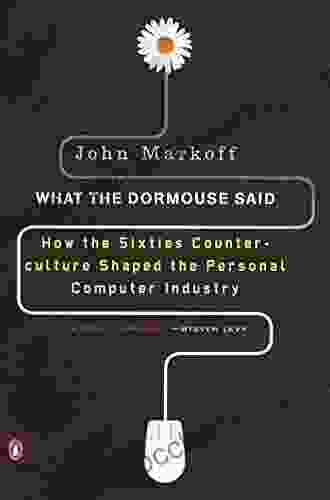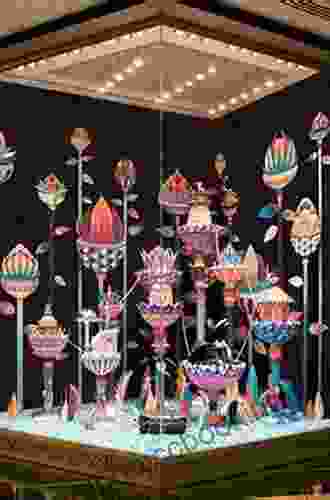Unveiling the Roots: How the Sixties Counterculture Nurtured the Birth of Personal Computing

The personal computer industry, a cornerstone of modern society, owes its origins not just to technological advancements but also to the transformative ideas that emerged from the counterculture movement of the 1960s. This article delves into this intriguing connection, exploring the ways in which the counterculture's embrace of experimentation, individualism, and the pursuit of personal growth laid the foundation for the development and proliferation of personal computers.
A Shared Spirit of Exploration and Experimentation
The counterculture movement, with its rejection of established norms and embrace of experimentation, fostered an environment where new ideas were welcomed and boundaries were pushed. This spirit of exploration extended to the realm of technology, where individuals began experimenting with early forms of computing.
4.3 out of 5
| Language | : | English |
| File size | : | 610 KB |
| Text-to-Speech | : | Enabled |
| Screen Reader | : | Supported |
| Enhanced typesetting | : | Enabled |
| Word Wise | : | Enabled |
| Print length | : | 333 pages |
Computer enthusiasts, many of whom were affiliated with the counterculture, gathered at "hackerspaces" and "computer communes." These informal groups provided a platform for collaboration, knowledge sharing, and the development of novel ideas. The willingness to experiment with different hardware and software configurations, often in a playful and non-commercial setting, led to significant advancements.
Personal Expression and the Pursuit of Individualism
The counterculture's emphasis on personal expression and individualism found resonance in the development of personal computers. Unlike the large, centralized mainframe systems prevalent at the time, personal computers offered individuals the opportunity to pursue their interests and explore their creativity.
Early personal computers, such as the Altair 8800 and Commodore PET, were marketed as tools that could be customized and programmed according to the user's desires. This freedom to tinker and create spurred innovation and fostered a sense of ownership and control over one's computing experience.
A Tool for Personal Growth and Enlightenment
The counterculture's search for personal growth and enlightenment also influenced the development of personal computers. Many individuals saw computers as instruments that could enhance their cognitive abilities, expand their knowledge, and facilitate introspection.
The development of educational software, such as the LOGO programming language and the Oregon Trail game, aimed to make learning interactive and engaging. The use of personal computers for personal organization, note-taking, and journaling became increasingly common. These applications reflected the counterculture's belief in the potential of technology to empower individuals and promote intellectual development.
A Network of Interconnectedness
The counterculture's emphasis on community and interconnectedness played a significant role in the dissemination of personal computing. Computer enthusiasts formed online communities through bulletin board systems (BBSs) and early forms of the internet. These networks facilitated the exchange of ideas, software, and hardware, fostering collaboration and a sense of belonging among users.
The decentralized nature of these networks mirrored the counterculture's rejection of centralized authority and its embrace of participatory democracy. The free flow of information and the ability for individuals to connect with others across geographical boundaries accelerated the growth and development of the personal computer industry.
A Catalyst for Industry Evolution
The convergence of the counterculture's values and the nascent personal computer industry had a profound impact on the trajectory of technological development. The industry began to shift away from a focus on large, centralized systems towards smaller, more affordable, and user-friendly personal computers.
Companies such as Apple, Microsoft, and Atari catered to the needs of these counterculture-influenced consumers, producing personal computers that were accessible, customizable, and geared towards personal use. The industry's adoption of the counterculture's values of experimentation, individuality, and personal growth fueled its rapid growth and transformation.
The influence of the Sixties counterculture on the personal computer industry is undeniable. The counterculture's embrace of experimentation, individualism, personal growth, and interconnectedness created a fertile ground for the development and proliferation of personal computers. The industry's subsequent evolution reflected the counterculture's values, with personal computers becoming tools for self-expression, intellectual growth, and community building.
By understanding this deep connection, we gain a unique perspective on the origins of the personal computer industry and its enduring impact on our lives today. The counterculture's legacy continues to inspire innovation, foster individuality, and empower individuals through the transformative power of technology.
4.3 out of 5
| Language | : | English |
| File size | : | 610 KB |
| Text-to-Speech | : | Enabled |
| Screen Reader | : | Supported |
| Enhanced typesetting | : | Enabled |
| Word Wise | : | Enabled |
| Print length | : | 333 pages |
Do you want to contribute by writing guest posts on this blog?
Please contact us and send us a resume of previous articles that you have written.
 Book
Book Novel
Novel Page
Page Chapter
Chapter Text
Text Story
Story Genre
Genre Reader
Reader Library
Library Paperback
Paperback E-book
E-book Magazine
Magazine Newspaper
Newspaper Paragraph
Paragraph Sentence
Sentence Bookmark
Bookmark Shelf
Shelf Glossary
Glossary Bibliography
Bibliography Foreword
Foreword Preface
Preface Synopsis
Synopsis Annotation
Annotation Footnote
Footnote Manuscript
Manuscript Scroll
Scroll Codex
Codex Tome
Tome Bestseller
Bestseller Classics
Classics Library card
Library card Narrative
Narrative Biography
Biography Autobiography
Autobiography Memoir
Memoir Reference
Reference Encyclopedia
Encyclopedia William P Young
William P Young Tina Nicastro Maom Lac
Tina Nicastro Maom Lac Jonathan White
Jonathan White Michael Schuman
Michael Schuman Joseph Woldu
Joseph Woldu Roland Huntford
Roland Huntford Jorge Chavarro
Jorge Chavarro Sandra Mizumoto Posey
Sandra Mizumoto Posey Jonathan Safran Foer
Jonathan Safran Foer Jonathan Mark Eaton
Jonathan Mark Eaton John N Carbone
John N Carbone Joseph Wambaugh
Joseph Wambaugh Muhammad Yunus
Muhammad Yunus Nick Schade
Nick Schade Robert W Winters
Robert W Winters Melissa Shook
Melissa Shook John Rothchild
John Rothchild Samantha Lovely
Samantha Lovely John Richard Stephens
John Richard Stephens Judi Whitton
Judi Whitton
Light bulbAdvertise smarter! Our strategic ad space ensures maximum exposure. Reserve your spot today!

 Herman MelvilleThe Inside Account of What Really Happened in Benghazi: An Unflinching Look...
Herman MelvilleThe Inside Account of What Really Happened in Benghazi: An Unflinching Look...
 Bobby HowardEmbark on an Unforgettable Literary Journey: Explore the Untamed Wilderness...
Bobby HowardEmbark on an Unforgettable Literary Journey: Explore the Untamed Wilderness... J.D. SalingerFollow ·18.8k
J.D. SalingerFollow ·18.8k William ShakespeareFollow ·8.1k
William ShakespeareFollow ·8.1k Hamilton BellFollow ·3.1k
Hamilton BellFollow ·3.1k Alexandre DumasFollow ·13.3k
Alexandre DumasFollow ·13.3k Ivan CoxFollow ·13.6k
Ivan CoxFollow ·13.6k Lord ByronFollow ·8.4k
Lord ByronFollow ·8.4k Felix CarterFollow ·7k
Felix CarterFollow ·7k Branden SimmonsFollow ·10.7k
Branden SimmonsFollow ·10.7k

 Joseph Foster
Joseph FosterUnravel the Enigmatic Murders in "Pride and...
Dive into a World...

 Jeffery Bell
Jeffery BellTrauma-Focused CBT for Children and Adolescents: The...
Trauma is a...

 Jorge Luis Borges
Jorge Luis BorgesSense and Second Degree Murder: A Jane Austen Murder...
Prepare yourself for a...

 Chase Simmons
Chase SimmonsUnleash the Vibrant World of Watercolor: An Enchanting...
In the world of art, watercolor painting...

 Rubén Darío
Rubén DaríoAmerican Funny Animal Comics In The 20th Century: A...
Step into a bygone era of laughter and...
4.3 out of 5
| Language | : | English |
| File size | : | 610 KB |
| Text-to-Speech | : | Enabled |
| Screen Reader | : | Supported |
| Enhanced typesetting | : | Enabled |
| Word Wise | : | Enabled |
| Print length | : | 333 pages |










